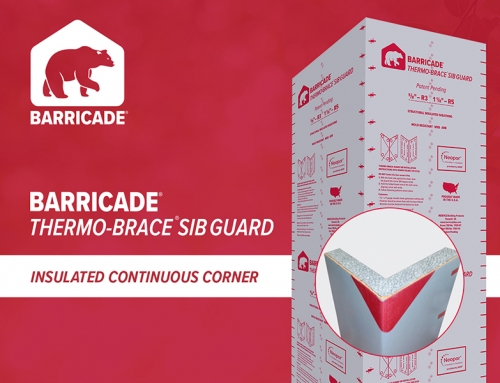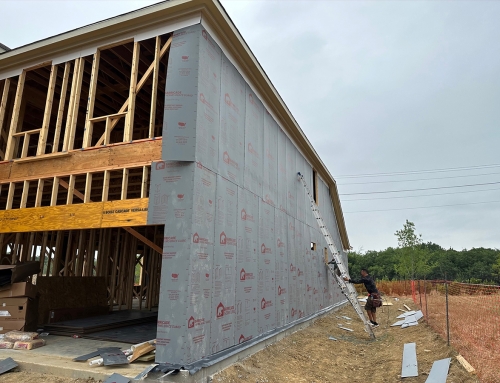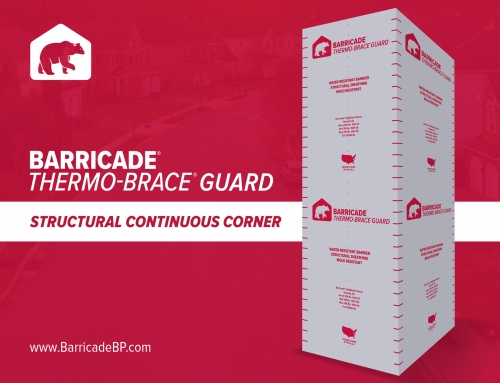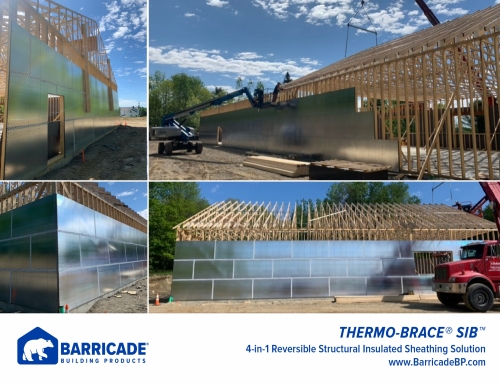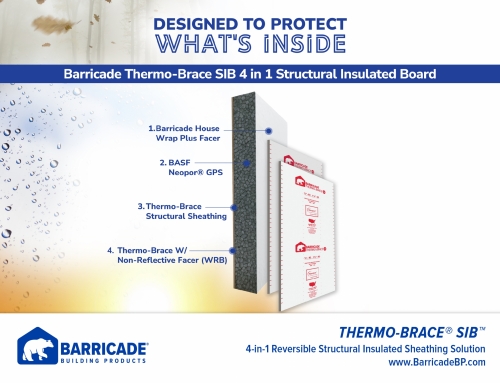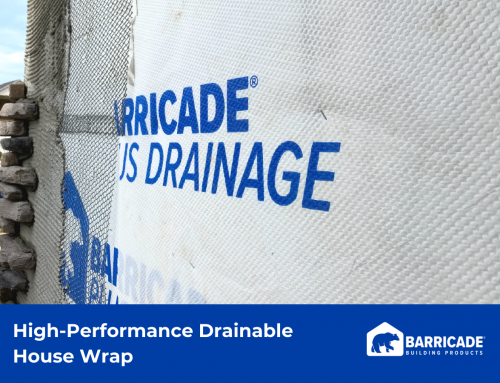The five energy-efficient must-haves for a modern home include continuous insulation (CI), an air and moisture barrier, high-efficiency heating and cooling systems, controlled ventilation, and energy-efficient window, doors, appliances, lighting, and home electronics. Two superior products for achieving CI and moisture- and air-resistance are the Barricade® Thermo-Brace® Structural Insulative Board (S.I.B) and Barricade® Building Wraps.
The Benefits of an Energy-Efficient Home
Homeowners want an energy-efficient house because it saves money by reducing energy use and provides greater comfort to its occupants. Also, energy-efficient design increases the resale value of the home and fights global warming. Fortunately, recent technological advancements in building products and construction methods make the process of building an energy-efficient home less challenging. The goals of an energy-efficient house are to achieve net-zero energy use and create a comfortable home with high indoor environmental quality (IEQ).
Five Must-Haves for an Energy-Efficient Home
Five must-haves for an energy-efficient home include CI, an air and moisture barrier, high-efficiency heating and cooling systems, controlled ventilation, and energy-efficient window, doors, appliances, lighting, and home electronics.
-
Continuous Insulation for an Energy-Efficient Home
A vital design element of an energy-efficient house is CI. Notably, the ASHRAE 90.1 and the International Energy Conservation Code mandate continuous insulation. The ASHRAE Standard 90.1-2013 defines CI as insulation that is uncompressed and continuous across all structural members without thermal bridges1 other than fasteners and service openings. The goal of CI is to stop thermal bridging, increase the effective R-value and eliminate condensation. Continuous insulation prevents air leakage (thermal bridging) in a home. Ultimately, CI saves homeowners money and energy by reducing mechanical ventilation costs and heating and cooling expenses.
Barricade Products Provide CI for an Energy-Efficient Home

Barricade Thermo-Brace S.I.B will provide CI for an energy-efficient home. Barricade Thermo-Brace S.I.B. has superior long-term thermal resistance and is available in R-5 and R-3 thicknesses. Importantly, Barricade Thermo-Brace S.I.B. meets the 2012, 2015, and 2018 International Energy Conservation Codes for continuous insulation sheathing.
Barricade Building Wraps create a continuous airtight barrier system. Application of Barricade Building Wraps ensures the energy efficiency, integrity and IAQ indoor air quality of a home. Notably, Barricade Building Wraps meet and surpass the requirements of the 2018 IECC R402.4.1 and C402.5.
-
Air and Moisture Barrier for an Energy-Efficient Home
Stopping air and moisture infiltration to the interior of a house is a critical design component of an energy-efficient home. Airtightness of a home eliminates thermal bridges. Moisture resistance prevents rot and the growth of mold and mildew, which can significantly degrade the IEQ of a home. To minimize air and moisture infiltration within a house, an air and moisture barrier, along with CI, is imperative to energy-efficient home design.
Barricade Products Provide Air and Moisture Resistance
Barricade Thermo-Brace S.I.B. has a weather-resistant barrier on both sides of the panel providing superior air and moisture management.
Barricade Building Wraps are a continuous air barrier system that controls air and moisture infiltration. Barricade Wrap is also permeable to vapor (11 US perms), which allows moisture to evaporate.
-
The Heating and Cooling System of an Energy-Efficient House

A home’s heating and cooling system accounts for 48 percent of its energy use. The design of an energy-efficient house must include high-efficiency heating and cooling systems that minimize energy use. For instance, the most energy efficient HVAC systems are 95 percent efficient; meaning 5 percent of the energy produced is lost. It is crucial that HVAC professionals correctly install the systems. Improper installation of an HVAC can reduce its efficiency by up to 30 percent. This is an important feature for homes in hot climates such as Atlanta.
-
Controlled Ventilation of an Energy-Efficient Home
Controlling ventilation of an energy-efficient home is vital because the air-tightness of an energy-efficient home may trap pollutants (like formaldehyde, radon, and volatile organic compounds). It is crucial for an energy-efficient home to install an energy recovery ventilation system. An energy recovery ventilation system controls ventilation and reduces energy loss by transferring energy from conditioned outgoing air to fresh incoming air. Other useful methods of ventilation for an energy-efficient home are spot ventilation, such as natural ventilation and exhaust fans in the bathroom and kitchen.
-
Energy-Efficient Glazings, Appliances, Lighting, and Home Electronics
- Glazings: Energy-efficient windows, skylights, and doors provide light, warmth, ventilation, and energy and cost savings. Design of an energy-efficient home must include energy efficient windows, skylights, and doors appropriate to the home’s climate zone.
- Appliances: An energy-efficient home includes energy-efficient appliances. Energy-efficient appliances reduce energy use, emit less air pollution and increase the resale value of a house. Energy-efficient home design should include ENERGY STAR appliances, which ensure the appliance saves energy and money and protects the environment.
- Lighting: Lighting contributes up to 15% of a house’s yearly electricity costs and is a vital design consideration of an energy-efficient home. Examples of energy-efficient lighting include light-emitting diodes (LEDs), compact fluorescent lamps (CFLs), and halogen incandescent. Controls such as dimmers, timers, and photocells will save money and energy.
- Electronics: The average home owns 24 electronic products, which are responsible for 12 percent of a house’s electricity use. The design of an energy-efficient house must include ENERGY STAR®-labeled office equipment and electronics.
1A thermal bridge allows energy and heat to flow through a section of the building envelope at a higher rate than the adjacent space and lessens the effective R-value of the building envelope.
Its effective R-value measures a building’s wall system’s resistance to this flow. The effective R-value includes all the products used in its construction: the siding, studs, drywall, fiberglass batts, sheathing, water control plane. The higher the R-value, the less the conductivities of the wall system.

